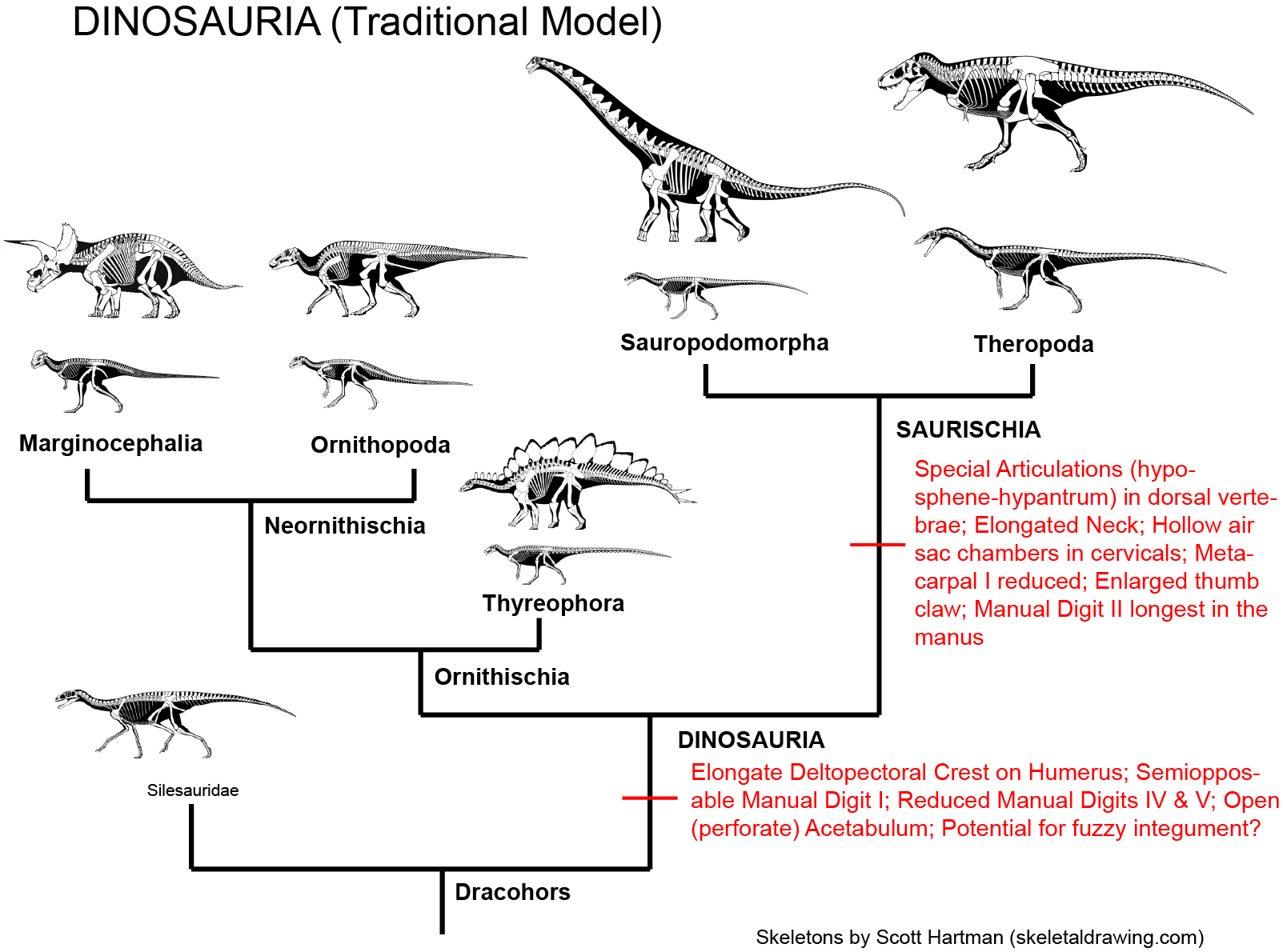

Terrestrial Vertebrates of the Mesozoic II: Reptilia
In Early Triassic, advanced therapsids remain the dominant group. However, rising
in diversity are the
diapsids (reptiles with a pair of openings behind the eye for jaw muscles, and
long hind legs allowing them to shift from
quadrupedal to bipedal mode when
speed is needed)
In the Middle and Late Triassic, massive radiation of diapsids into:
Among the most successful branch are the archosaurs (diapsids with an extra opening between the eyesocket and the nostril, possibly housing soft tissue associated with cooling the face, and an advanced breathing system).
In the Middle and Late Triassic, archosaurs dominate most terrestrial ecosystems, the archosaurs displaced the therapsids as the dominant group of large terrestrial amniotes.
Archosaurs are divided into two main branches:
It is the crurotarsan which dominated the Middle and Late Triassic. This group radiated into a number of forms:
The crurotarsans include some of the first terrestrial animals to exceed the size of oxen and hippos. Most of them could stand with a semi-erect posture of the limbs, and a few had the fully-erect (that is, parasagittal gait).
Although crurotarsans may have been the dominant group, plenty of other forms abounded in the Middle and Late Triassic. These included the last of the big beaked therapsid herbivores; more advanced, but generally small therapsids (including the oldest mammals); many non-archosaurian diapsids (see above); and...
The First DINOSAURS!
During the Late Triassic, the origin of many modern groups, including:
During the Triassic-Jurassic Extinction, many victims on land:
During the Jurassic, diversification among most surviving land vertebrates. Origin of first pterodactyloids (advanced specialized short-tailed pterosaurs)
During the Cretaceous: first snakes (modified legless lizards, close in origin to mosasaurs)
However, most important diversifications occur in Dinosauria
The Dinosaurs: Coolest Critters Ever
Dinosaurs and their closest relatives and ancestors (together, the dinosauromorphs) are notable in their hindlimbs:
The combination of these traits allowed the little dinosauromorphs to run and accelerate in a bipedal mode all the time, not just at top speeds like typical diapsids. (It is not yet certain if the earliest dinosauromorphs such as Lagerpeton and Marasuchus were primarily quadrupeds or bipedal.
The parasagittal gait and hinge-like ankle also allowed dinosauromorphs the ability to move more actively and constantly rather than only in short bursts of speeds; thus, they were striders. Additionally, although early dinosauromorphs were small (~30 cm long for Marasuchus, 1-2 m long for silesaurs and basal dinosaurs, etc.), the presence of limbs directly underneath the body meant that this lineage to grow to much larger size than any previous clade while still remaining terrestrial and mobile (sprawlers relagated to a semi-aquatic life if they became too big to support their weight).
The first true dinosaurs are known from fossils around 228 Ma (the very beginning of the Late Triassic), and so the group as a whole probably first evolved slightly earlier (in the Middle Triassic). Early dinosaurs were all small (1-2 m long), bipedal (walked on their hind legs), and had grasping hands.
From the first dinosaurs evolved many different branches:

These branches included:
Among the diversity of carnivorous dinosaurs were some that evolved a covering of fur-like hollow structures. These protofeathers were probably originally for insulation, but became adapted by more specialized forms into true feathers. There were many lineages of feathered dinosaurs, one of which includes modern birds and their Mesozoic ancestors. Birds are therefore a group of dinosaurs: they are descendants of the most recent common ancestor of Iguanodon and Megalosaurus. Bird radiation continued throughout Cretaceous, with many groups of sea birds and land birds
Dinosaurs hatched from eggs, and even the largest dinosaurs grew from babies that could fit in an egg the size of a soccer ball. Recent studies show that it took big dinosaurs only 7 to 20 years to reach full size! This, along with many other lines of evidence, suggests that dinosaurs had active metabolisms, more like mammals (and modern birds) than like lizards and crocodilians:
With break up Pangaea, diversification and provincialization of dinosaur faunas. Dinosaurs of Gondwana distinct from Laurasia.
Dinosaur groups rose, diversified, and went extinct throughout the Mesozoic. Remained the dominant group of terrestrial vertebrates until the end of the Cretaceous.
For more information, take GEOL 104 Dinosaurs: A Natural History, Fall Semesters, CORE PS.
To Next Lecture.
To Previous Lecture.
To Syllabus.